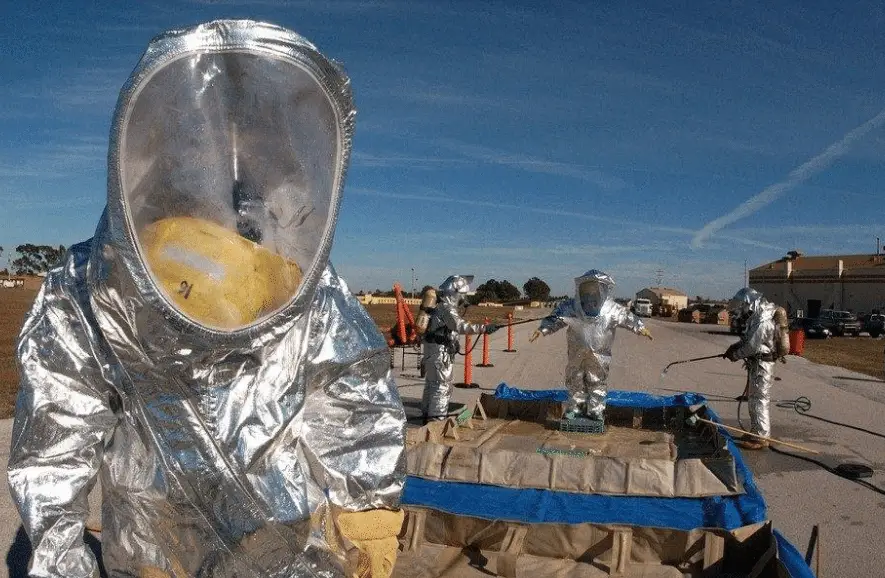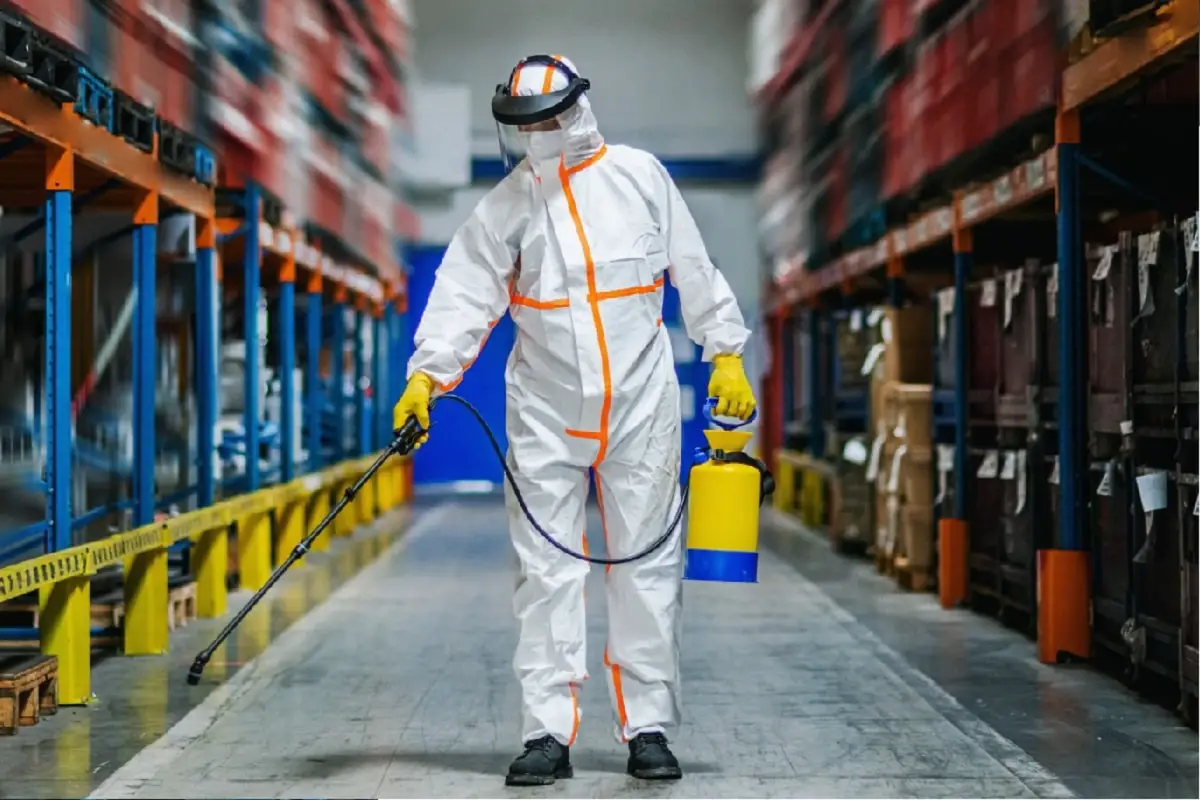In this article, we discuss the essential factors you need to consider when choosing the right hazmat suit. This information can save your life so choose wisely!
For industrial and healthcare workers who come in contact with hazardous substances frequently, the job site can be as dangerous as a battlefield. A hazmat suit is an essential piece of personal protective equipment (PPE) designed to protect the wearer from these environmental hazards.

Hazmat suits are used by a wide variety of professionals including:
- Biological researchers
- Firefighters
- Medical technicians
- Paramedics
- Toxic spill cleanup specialists
- Environmental contamination remediators
- Military personnel
- Industrial workers
A hazmat suit can protect the wearer from a large variety of chemical and biological agents, whether it is a light splash or heavy exposure.
How Does a Hazmat Suit Work?
According to the United States Department of Homeland Security, a hazmat suit is “an overall garment worn to protect people from hazardous materials or substances, including chemicals, biological agents, or radioactive materials.”
These suits are made of special chemical-resistant, airtight materials, like PVC or rubber, Teflon, Tyvek, or other reflective and/or insulating materials. These fabrics isolate the individual from the environment, and are flexible to allow relatively free movement without major hindrance.
Hazmat suits provide protection from chemical, biological, and nuclear agents as well as extreme temperatures. The type of task and level of risk dictate what type of hazmat suits should be used.
Many hazmat suits are gas-proof to prevent unwittingly inhaling or coming into contact with toxic gas or powder. Other suits enable the wearer to withstand high temperatures and smoke using heat-resistant material and a breathing apparatus to supply clean air.
You can learn more about how hazmat suits work in this article.
Protection Levels of a Hazmat Suit

Different hazmat suits are designed to protect the wearer from different threat levels and substances. It is essential to know what a hazmat suit is designed to protect against. This is determined by the following standard hazmat suit protection levels.
For example, a PVC suit would protect you from chemical fumes, but wearing it in case of a fire would be a terrible idea — it will melt.
Therefore, wearing the right hazmat suit depends on what crisis you are facing. Some environments contain just one hazard, like exposure to suspected carcinogenic materials. But others may poses multiple dangers like flames or corrosive materials.
This is where the different protection level of hazmat suits come in. These levels were created by OSHA.
Level A
Level A suits are fully encapsulated and completely isolated from the outside environment. These suits are equipped with a full face shield and consist of a breathing apparatus that is contained within the suit — which is why they look so huge and cumbersome.
Level A suits are designed for zero risk to deal with contamination from unknown origin. These suits are vapor-tight and offer a high level of protection from airborne or direct chemical contact.
If there is a possible incident that can risk your health or life, a Level A hazmat suit is the choice to wear. A Level A suit provides full protection against splashes, fumes, and other dangerous substances.
They are also paired with chemical-resistant gloves and shoes with steel toe and soles and wearers have to carry two-way communication.
Level B
Level B suits are similar to Level A suits but have a lower level of protection. These suits are not vapor-tight. They are appropriate for use in environments in which gases don’t harm the skin. They also come with an air apparatus, which may or may not be fully encapsulated within the suit.
These suits protect against hazardous chemical splashes, but do not provide protection against toxic gases. In addition, you need to wear chemical-resistant gloves and shoes with steel toes with a Level B suit.
You will need to carry your own two-way radio communication, as Level B suits don’t have radios built in.
Level C
Level C has a lesser level of protection than Level B hazmat suits. These hazmat suits consist of overalls and are worn with an air-purifying gas mask as opposed to an isolated air tank.
Level C hazmat suits are worn in environments with known hazardous chemicals and airborne substances, but not chemical crisis or oxygen-deficient situations.
Most firefighters wear Level C hazmat suits.
Level C suits are worn along with a hard hat and chemical-resistant outer boots.
Level D
Level D protection does not protect workers from chemical exposure. These hazmat suits are only worn in placed where there is no risk of chemical or gas exposure. They typically consist of a pair of overalls, chemical-resistant boots with steel toes, and glasses.
Level D suits are not generally considered hazmat suits. They are usually only worn for splash protection and do not include any respiratory protective equipment.
Types of Hazmat Suits
Another way to determine whether a certain hazmat suit is appropriate for the level of exposure is to find out the suit type classification on the PPE label.
Hazmat suit types range from Type 1 to Type 6.
| Hazmat Suit Type | Protection From |
| Type 1 | Hazardous material, explosives, chemicals |
| Type 2 | Flammable gases and liquids |
| Type 3 | Splashes, sprays, acids |
| Type 4 | Dyes, crude oil, petroleum, machine oil |
| Type 5 | Airborne particulates |
| Type 6 | Dust, dirt, airflow |
A Type 1 chemical suit is fully covered and provides complete protection from exposure to hazardous material. These suits are appropriate for Level A hazards.
The manufacturer of Type 1 chemical suits should provide you with a full list of the chemicals it is designed to protect against as well as the tests it passed.
Type 1 hazmat suits are also broken down further into subclasses that cover explosives which range from 1.1 to 1.6.
Type 2 hazmat suits are non-gas tight suits that protects against flammable gases and liquids.
Type 3 and type 4 hazmat suits provide protection against splashes and have spray-tight and liquid-proof seams and joints. Type 3 hazmat suits are majorly formed from layered PVC and provide good protection from low levels of acids. It is also reusable.
A Type 4 hazmat suit provides excellent protection against liquids like dyes, crude oil, machine oil, and petroleum. These suits are also reusable since they do not come in contact with chemicals that are harmful to breathe.
Type 5 hazmat suits protect against dry particulates that are airborne for a limited period of time.
Type 6 suits are the most basic level of hazmat suits and are designed to only provide protection from dust and other nuisance. These garments are worn with gloves and safety shoes.
Styles of Hazmat Suits

The style of a hazmat suit dictates the level of protection. Manufacturers offer different styles of hazmat suit designed to meet the different Levels and Types above.
Totally-Encapsulating Suits
These suits are made of chemical-resistant material and are worn during Level A hazards. These suits consist of a self-contained breathing apparatus that is also encapsulated inside the suit. Workers also have to wear inner chemical-resistant gloves and steel-toed boots and maintain two-way radio communication to protect against unknown chemical exposures.
Hooded Chemical-Resistant Suits
Hooded chemical resistant suits are used in Level A and B hazard risks and come with an air respirator or air tank. They have excellent liquid-resistant properties and workers can wear them during industrial spill cleanup operations.
One / Two-Piece Chemical Splash Suits
These splash suits are provide good protection against liquid splashes and are used during Level C assignments where all contaminants are known.
Chemical-Resistant Coveralls
These overalls protect the worker from light liquid splashes and hazardous dust and debris. These are usually worn in low-danger environments like when you are doing spray painting or in the metal polishing industry.
What to Consider When Buying A Hazmat Suit
The National Fire Protection Association’s NFPA 1991 is the gold standard when it comes to hazmat suit safety certifications. Chemical suits that have this certification undergo rigorous chemical and physical tests.
Here are some things you need to consider when buying a hazmat suit:
Weight
Weight should be a major factor in the selection of hazmat suits as it is directly proportional to its endurance and safety in the field. The number of layers used to make a hazmat suit are reflected in the total weight.
Single-layer suits can be beneficial as they are lighter and can save the worker from bearing as much as 8 pounds of extra load.
For an emergency worker, every loss in pound means less effort expended on movement and more spent on doing his or her job.
Material
The right material means adequate protection while the wrong material can expose you to hazardous elements.
Materials used to make hazmat suits include rubbers, floropolymers, and thermoplastics. Rubber hazmat suits are often heavy and stiff. Fluoropolymers can withstand a heat up to 500 degree Fahrenheit without material degradation, while thermoplastic have a risk of melting when temperature reach 300 degrees.
The type of material used also affects the durability of your hazmat suit. If your suit is NFPA 1991-certified, it will pass the abrasion test. In case of damage, will continue to provide protection against chemical permeation.
Maneuverability
When considering buying a hazmat suit, you need to consider each and every component. Make sure that when you wear the outfit, you can easily stand, bend, sit, squat, turn and extend your arms without any hindrance.
When trying out the gloves, make sure they allow your fingers to bend easily. Single-skin gloves offer improved dexterity. They also mean that no layers can be removed, ensuring maximum protection.
Multi-layer gloves also can turn inside out making it difficult to reinsert your hand.
Visibility
Visibility is crucial in hazardous environment. Whether you are navigating through a toxic environment or just inspecting a gas leak, your visor needs to be properly in place.
Some poorly made visors hang loosely on your face, effecting visibility. The visor should rest comfortably across the wearer’s brow line with the help of the internal pressure from the suit.
Some of the best hazmat suits come with a visor directly welded to the suit so that it does not dislodge and move out of place.
Internal Belt Systems
Not all hazmat suits come with internal belts, but they can be extremely important. When buying your chemical suit, look for one with an internal belt which attaches the suit to the wearer’s waist. This belt holds the suit up to your waist level, promotes stability, and eases pressure off the shoulders and neck.
Hazmat Suits – Frequently Asked Questions
If you have more questions about hazmat suits, read through these FAQ articles below. You are likely to find the answer you need.
- What is a hazmat suit?
- What is a CDC hazmat suit?
- What jobs require hazmat suits?
- What are OSHA’s hazmat suit requirements?
- How to use a hazmat suit?
- What is the history of hazmat suits?
- How do hazmat suits work?
- What are the standard hazmat suit protection levels?
Choosing the Right Hazmat Suit is Essential
Nobody wants to be in a situation where they need to wear a hazmat suit. However, in case of a chemical, nuclear or biological threat, hazmat suits can save lives.
To be truly safe, you need to wear a hazmat suit in conjunction with appropriate gloves and footwear. In case of airborne risks, an air tank or mask is essential.
Make sure you are wearing the type of hazmat suit hat is appropriate for the level of exposure. Any negligence in this area can have deadly consequences.

